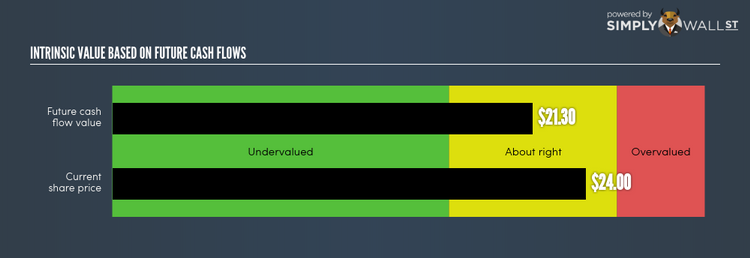Independent Bank Corporation (NASDAQ:IBCP) Investors Are Paying Above The Intrinsic Value

Bank stocks such as IBCP are hard to value. This is because the rules banks face are different to other companies, which can impact the way we forecast their cash flows. For instance, banks must hold a certain level of cash reserves on the books as a safety precaution. Examining data points like book values, in addition to the return and cost of equity, is practical for estimating IBCP’s intrinsic value. Below I’ll take you through how to value IBCP in a reasonably accurate and straightforward way. Check out our latest analysis for Independent Bank
What Is The Excess Return Model?
Financial firms differ to other sector firms primarily because of the kind of regulation they face and their asset composition. United States’s financial regulatory environment is relatively strict. In addition to this, banks usually do not possess large amounts of physical assets on their books. So the Excess Returns model is suitable for determining the intrinsic value of IBCP rather than the traditional discounted cash flow model, which places emphasis on factors such as depreciation and capex.
How Does It Work?
The key assumption for this model is that equity value is how much the firm can earn, over and above its cost of equity, given the level of equity it has in the company at the moment. The returns above the cost of equity is known as excess returns:
Excess Return Per Share = (Stable Return On Equity – Cost Of Equity) (Book Value Of Equity Per Share)
= (12.93% – 9.91%) * $15.15 = $0.46
Excess Return Per Share is used to calculate the terminal value of IBCP, which is how much the business is expected to continue to generate over the upcoming years, in perpetuity. This is a common component of discounted cash flow models:
Terminal Value Per Share = Excess Return Per Share / (Cost of Equity – Expected Growth Rate)
= $0.46 / (9.91% – 2.47%) = $6.15
Putting this all together, we get the value of IBCP’s share:
Value Per Share = Book Value of Equity Per Share + Terminal Value Per Share
= $15.15 + $6.15 = $21.3
Compared to the current share price of $24, IBCP is , at this time, fairly priced by the market. This means there’s no real upside in buying IBCP at its current price. Pricing is only one aspect when you’re looking at whether to buy or sell IBCP. Fundamental factors are key to determining if IBCP fits with the rest of your portfolio holdings.
Next Steps:
For banks, there are three key aspects you should look at:
Financial health: Does it have a healthy balance sheet? Take a look at our free bank analysis with six simple checks on things like bad loans and customer deposits.
Future earnings: What does the market think of IBCP going forward? Our analyst growth expectation chart helps visualize IBCP’s growth potential over the upcoming years.
Dividends: Most people buy financial stocks for their healthy and stable dividends. Check out whether IBCP is a dividend Rockstar with our historical and future dividend analysis.
For more details and sources, take a look at our full calculation on IBCP here.
To help readers see pass the short term volatility of the financial market, we aim to bring you a long-term focused research analysis purely driven by fundamental data. Note that our analysis does not factor in the latest price sensitive company announcements.
The author is an independent contributor and at the time of publication had no position in the stocks mentioned.

